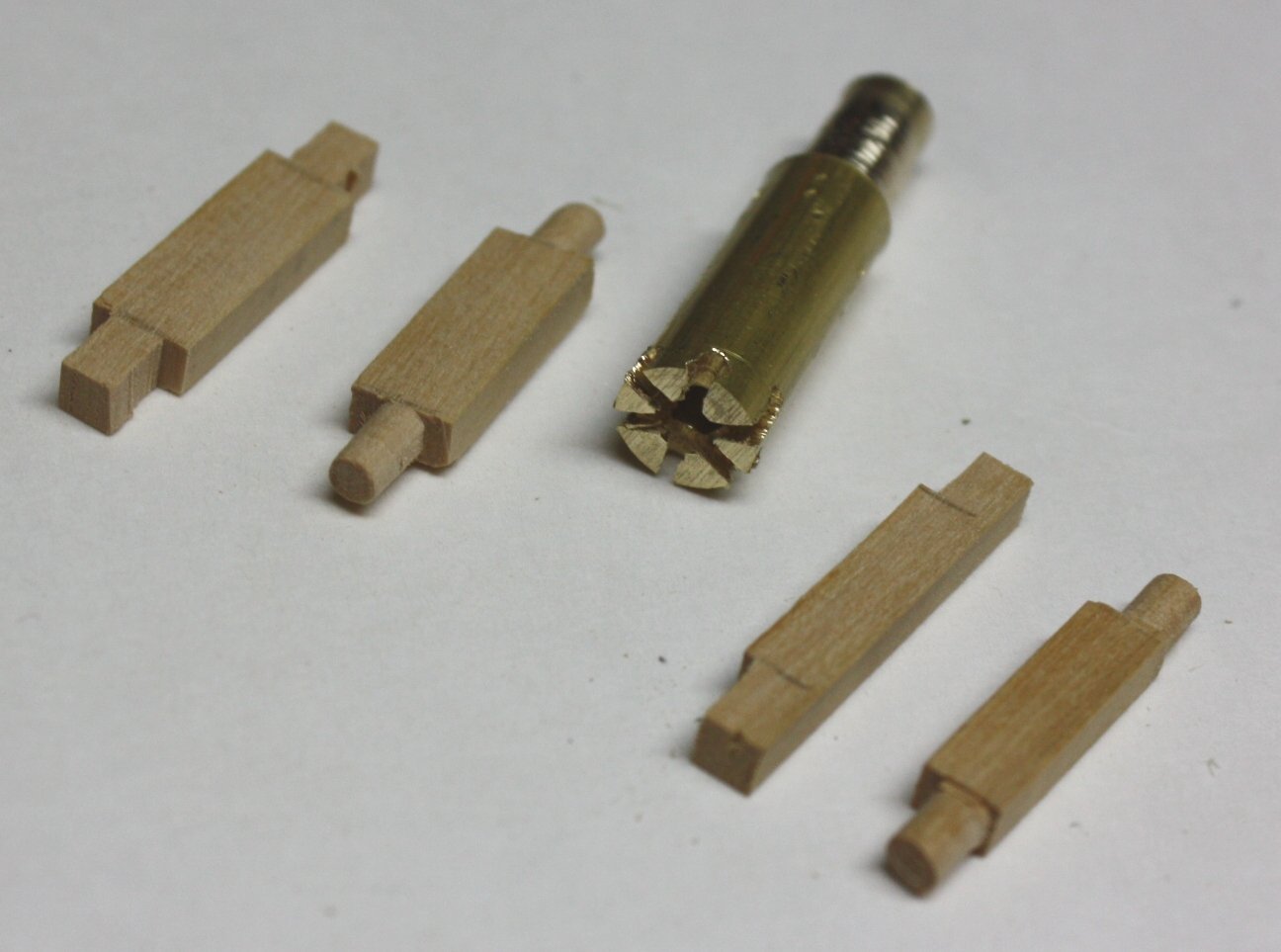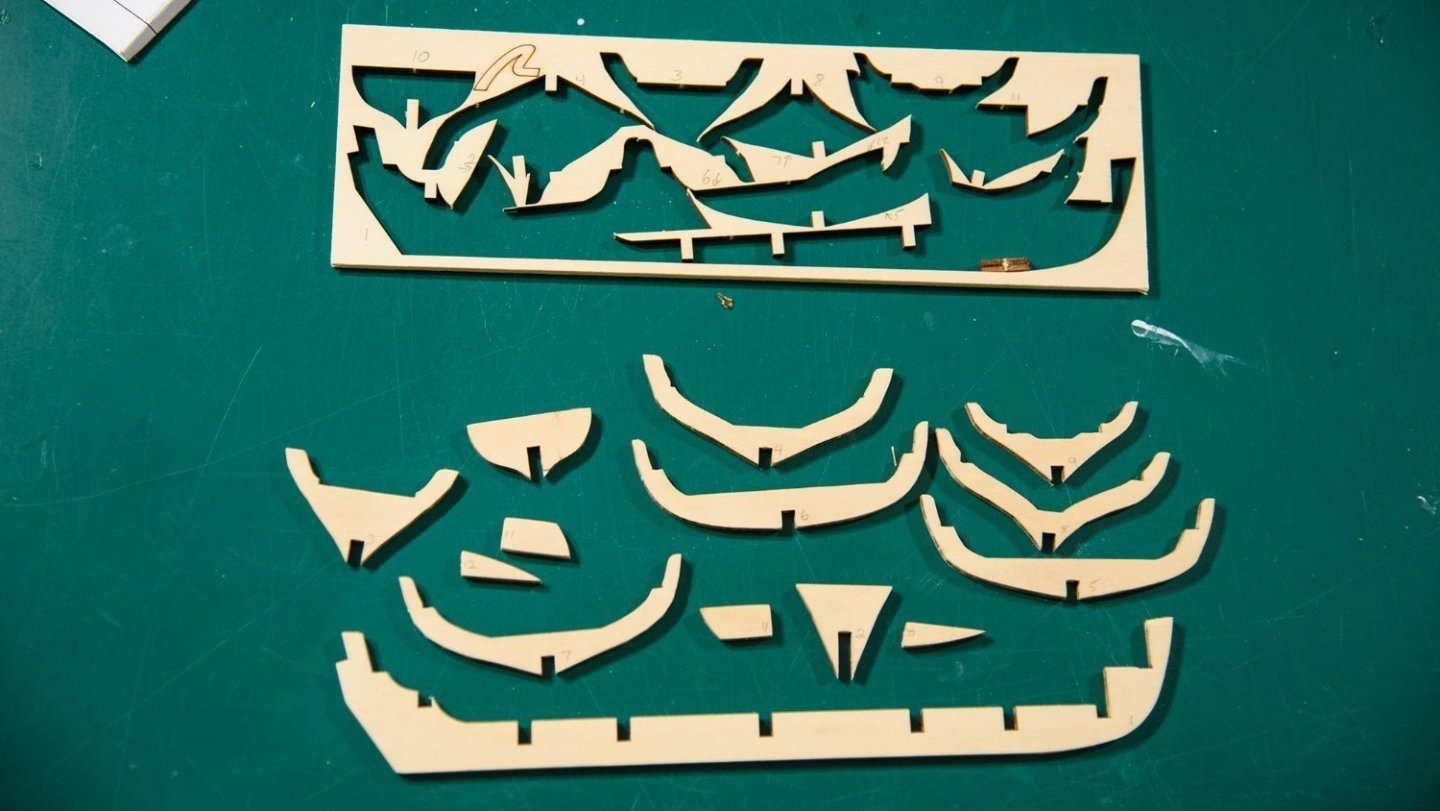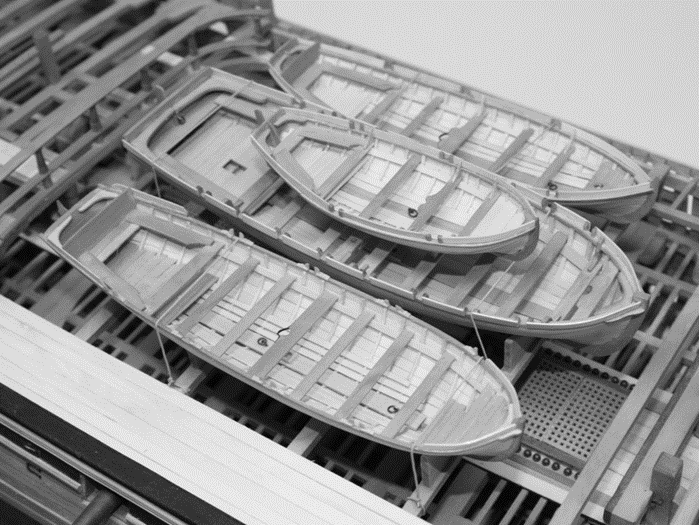-
Posts
8,149 -
Joined
-
Last visited
Content Type
Profiles
Forums
Gallery
Events
Everything posted by allanyed
-
I have found that is far easier to make the gratings first so there are no openings on the periphery then make the coamings and head ledges to fit around the gratings. They may be slightly off dimension wise from the plans, but they will look like those that you did so well on the lower deck. Allan
- 218 replies
-
- Victory
- Caldercraft
-
(and 1 more)
Tagged with:
-

Running rigging termination location help
allanyed replied to Peanut6's topic in Masting, rigging and sails
Kev, Your comment brought a huge smile because that is the truth of it as you know. So many folks buy this kit thinking it represents the boat Bligh sailed with his 18 shipmates when it does no such thing. Sorry I cannot help on the belaying issue. I did spend a little time going through some photos of ships' boats at the RMG site, but did not find any contemporary models that were rigged. Allan -
Thanks Ben, I was very lucky to have had gain explained to me. including the drawing above before making ship's boats for Euryalus and others since, so had no difficulty in adding this feature of the construction even at 1:48. I think if you give it a try on a future build you will see that it does take some extra time but really is not at all difficult. Again, your build looks great and from the pictures it is obviously a much better kit than most, if not all, of the other boats kits seen in build logs here and other ship modeling sites. Allan
-
Jason I admire the fact that you are replacing metal with wood where appropriate! The cannons look lovely, but FWIW, the next time consider that the axles stick out past the trucks so a retainer spike or pin can be put in place. Also, rounding the axles is a breeze if you have a drill and a hacksaw to make a small cutting tool of brass, steel, or aluminum. Pictures and a 1000 words, yadda yadda The simple sketch is based on the more detailed drawings found in Volume II of Caruana's The History of English Sea Ordnance. As to tackle on the cannon, note that most contemporary models show no rigging or just the breech rope. There are exceptions, but that seems to be norm if you research photos of models at RMG as one example. At least with a smaller vessel and subsequently smaller cannon, at least the blocks should all be singles, no doubles if you do rig the running tackle. Allan
-
Elmina On what schooner and year is the model based? Also do you know the provenance of the model? She looks to be quite nicely detailed! Thanks Allan
-
Very nice work Ken! I have looked at pictures of various Bounty "jolly boat" builds here and comparing the photo of the frames above I just noticed the overall shape looks nothing like a launch, but rather, a cutter, and I wonder why this was done. As mentioned earlier the famous journey did not use the jolly boat which was rotted, nor the cutter which was too small and leaked, but rather the launch. The below shows what I mean about the shape. The sketch below is a collection take from various contemporary plans at RMG. Allan
- 62 replies
-
- Bounty Jolly Boat
- Artesania Latina
-
(and 1 more)
Tagged with:
-
Thanks SU., what you are saying makes total sense. We were up near you last a week ago for a long weekend in New Hanover with kids and grandkids. We love driving the back roads in your area, seeing many of the 300+ year old stone houses and hillsides with spring showing through. Allan
- 111 replies
-
- Swift
- Artesania Latina
-
(and 3 more)
Tagged with:
-
SU I hope you don't mind my asking but I am curious why the strops on the blocks are wire instead of rope? I do not recall having ever seen this kind of rigging on a model or in any book based on contemporary information except for VERY small scale models such as made by McNarry and McCaffery. Thank you Allan
- 111 replies
-
- Swift
- Artesania Latina
-
(and 3 more)
Tagged with:
-

Cutty Sark(Revell 1:96) rigging confusion
allanyed replied to Terry Foster's topic in Masting, rigging and sails
Royal Museums Greenwich of which the actual Cutty Sark is a part, has rigging plans of Cutty Sark for as little as 8 pounds Sterling. Allan -
David, FWIW, on future builds at small scales such as 1:64, or even 1:48, you may want to consider a totally different method of boat building. Wayne and I included a chapter on making boats with relative ease using the plug system in Volume II of Euryalus on pages 104-114, including the final photo below.
-
Hi David, I have about 50 high resolution contemporary and redrawn plans of long boats, cutters, launches, pinnaces, yawls, and barges. If you are interested in some or all of these, feel free to PM me. The file is over a gig in size. Also there are tables of scantlings for everything from the keel to the frames, to the thwarts, to the ears at the bow in W.E. May's book, The Boats of Men of War. Just as an FYI, according to Mays, by 1781, 5th rates carried at least 5 boats. For a 36 (and presumably for a 38 gun like Diana) this would include a 24 foot launch, a 30 foot pinnace, two 24 foot cutters and an 18 foot cutter so there is a lot of boat work if you want to include more than one or two. 😀 Allan
-
Dave Model Shipways Shipwright series is a great way to start off! There are additional great kits as well, but also some others that are difficult to work with and are avoided by many folks due to poor materials, poor instructions, and design details such as gratings, belaying pins, etc. that look nothing like what is found on a real ship or a well scaled model. Study the build logs here at MSW and compare to photos of contemporary models and plans on various websites like RMG Collections to get a better idea of which kits will suit your needs and tastes in the future. Allan
-
Thanks to each of you! These are similar to methods I have used in the past and will continue to use. I usually thickness sand a slab to the thickness I need (0.015 to 0.04 depending on the scale) then slice with a scalpel and straight edge. I have ordered a slitter similar to the one Pat shows to give it a try. I have a good stock of white holly I like to use for deck planking that I am also using for the light frames well. It looks good, but castello has sharper edges even if not as "bright" Thanks again Allan
-

NAIAD 1797 by Bitao - 1:60
allanyed replied to Bitao's topic in - Build logs for subjects built 1751 - 1800
Bitao, The hammock battens were to secure the crew's hammocks for sleeping. There is are a couple drawings of the hammock arrangements on the RMG Collections site. https://www.rmg.co.uk/collections/objects/rmgc-object-86594 https://www.rmg.co.uk/collections/objects/rmgc-object-86584 Keep up the great work! Allan -

NAIAD 1797 by Bitao - 1:60
allanyed replied to Bitao's topic in - Build logs for subjects built 1751 - 1800
Continuing to be a very very lovely work. The inclusion of the hammock battens is a great extra touch not often seen in the build logs. Allan -
It takes time to do things neatly and accurately in this hobby of ours. Why are you not able to get glue on the underside of the entire plank? Maybe I am misinterpreting your problem. Looking for a fast way to do something usually is not a good idea. I see no advantage in taping planks together then gluing them down all at once, but I see a lot of potential problems. Maybe someone has done as you are suggesting though, it will be interesting to see. Never too late to learn something new. Allan
-
Thanks for the post David. Reading this gave me goosebumps. I can only imagine my own mind set if I was able to see and touch these artifacts. Allan
-
Kev, Roger brings up a great point that was addressed in an earlier post here at MSW that you and other folks may or may not have seen. According to the Pitcairn Island Studies Center, Bounty carried three boats. Her jolly boat was leaky and could not be used and her cutter was too small for the 19 men that wanted to leave the ship, thus they used the 23 foot launch for Bligh and the other 18 men. The kit design and the contemporary design of a launch have differences. The below is a more detailed drawing of a 23 foot launch that was posted previously. It is based on several sources of contemporary information. The PDF is more clear once opened than the jpg, but both are below. Note that the anchor handling davit in the stern was not permanently in place thus was likely not on board during her famous voyage. Allan 23 Foot Launch circa 1795.PDF
-
Peanut, As you are talking about the launch, not the ship, keep in mind the launch was more often powered by oars. The masts on boats were stepped and rigged on a temporary basis so rigging had to accommodate this need for temporary duty yet be seaworthy. Look at photos of contemporary models that are rigged. There is at least one really good photo in the RMG Collections site that may be of some help. https://www.rmg.co.uk/collections/objects/rmgc-object-66291 This same model is explained in some detail regarding the rigging in W. E. Mays book The Boats of Men of War on page 93. It is not high resolution but hopefully useful and you can purchase a high res version if you need one. There may be more plans and models available to study on the RMG site for which you can do a search. I would trust these before modern drawings that you might be using unless the ones you have are based on contemporary sources. Allan
-
I am considering buying a square hole draw plate to make very small material for the framing of the stern lights (the windows, not the lanterns). Does anyone have experience with using a square hole plate for wood and if the experience is positive, a recommended brand? I see them in a variety of size ranges and prices from under $20 to $80. In addition, based on your experience, what wood species work well? I would love to use holly for its color, but would be OK with box or castello or other similar color species. TIA Allan
About us
Modelshipworld - Advancing Ship Modeling through Research
SSL Secured
Your security is important for us so this Website is SSL-Secured
NRG Mailing Address
Nautical Research Guild
237 South Lincoln Street
Westmont IL, 60559-1917
Model Ship World ® and the MSW logo are Registered Trademarks, and belong to the Nautical Research Guild (United States Patent and Trademark Office: No. 6,929,264 & No. 6,929,274, registered Dec. 20, 2022)
Helpful Links
About the NRG
If you enjoy building ship models that are historically accurate as well as beautiful, then The Nautical Research Guild (NRG) is just right for you.
The Guild is a non-profit educational organization whose mission is to “Advance Ship Modeling Through Research”. We provide support to our members in their efforts to raise the quality of their model ships.
The Nautical Research Guild has published our world-renowned quarterly magazine, The Nautical Research Journal, since 1955. The pages of the Journal are full of articles by accomplished ship modelers who show you how they create those exquisite details on their models, and by maritime historians who show you the correct details to build. The Journal is available in both print and digital editions. Go to the NRG web site (www.thenrg.org) to download a complimentary digital copy of the Journal. The NRG also publishes plan sets, books and compilations of back issues of the Journal and the former Ships in Scale and Model Ship Builder magazines.






